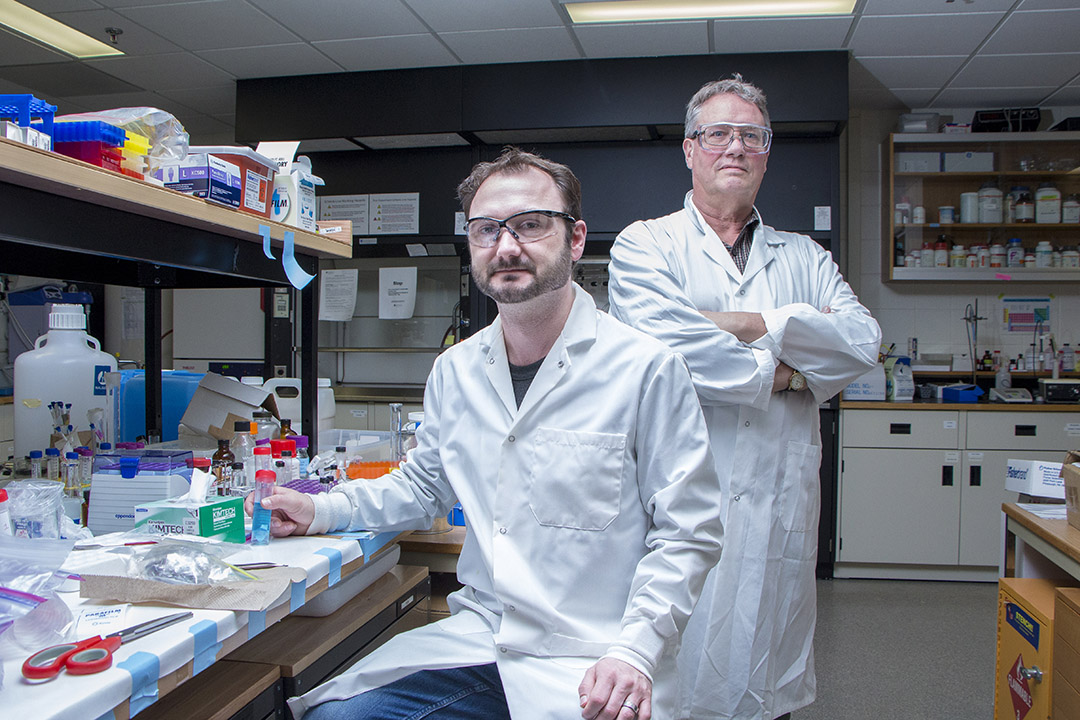
Fix for synchrotron research flaw could improve results
One of science’s essential tools for understanding the molecules of life has a glitch.
By Chris PutnamUniversity of Saskatchewan researchers have found that chemicals commonly used to protect samples in synchrotron experiments actually help to damage those samples, potentially misleading scientists around the world.
“Because of this discovery, we have changed the way that we operate in our lab, and we’re hoping to change the way that other people operate,” said Kurt Nienaber, a PhD candidate in the Department of Geological Sciences and lead author on the research.
The findings, published in a recent issue of The Journal of Physical Chemistry Letters by researchers from the College of Arts and Science and the College of Medicine, apply to X-ray absorption spectroscopy and protein crystallography: important X-ray-based methods used to understand the structures of molecules.
In these techniques, samples of matter are blasted with a beam of X-rays, typically from a synchrotron light source. From the interactions between the X-rays and the samples, scientists learn detailed information about the positions of atoms in biological molecules and deduce how these molecules work within living things.
To protect the delicate samples from freezing damage at the extremely low temperatures required by the experiments, chemicals called cryoprotectants are added. But there is a risk of another kind of damage when subjecting samples to intense X-rays; the radiation can cause chemical changes within the samples through a process called photoreduction.
A small amount of photoreduction is expected in synchrotron X-ray research. But the U of S researchers found that treating samples with common cryoprotectants such as glycerol has an unexpected side effect.
“It turns out that adding certain cryoprotectants was actually making the problem of photoreduction a lot worse,” said Nienaber. “This chemical change was happening at a tenfold rate when we introduced the glycerol. So that was quite a surprise for us.”
The transformation can be easy to overlook, which means that in many cases scientists using X-ray techniques might “not be studying what they think they’re studying,” said Graham George, professor of geological sciences, Canada Research Chair in X-ray Absorption Spectroscopy, and Nienaber’s PhD supervisor.
George co-authored the paper along with Professor and Canada Research Chair in Molecular Environmental Science Ingrid Pickering and research associates Jake Pushie and Julien Cotelesage.
The discovery could have major implications on the many branches of science in which protein crystallography is a crucial tool, including medicine.
“Basically, almost every modern medicine development, every new drug, has a component of protein crystallography in it,” said George.
Getting accurate information is vital in this work. If researchers developing a new drug didn’t realize they were looking at a photoreduced sample, George said, “we would be potentially misleading ourselves. Perhaps we’d end up following the wrong lead, and we’d fail to produce an effective drug.”
The discovery will not mean throwing away past crystallography research results, which are “still incredibly useful,” said George. But in many cases, researchers might need to go back and reexamine their findings.
Armed with this new knowledge that cryoprotectants come with a catch, scientists will be able to correct for the problem. The U of S researchers have already found ways to mitigate the issue—such as adding compounds that protect against the damage or decreasing the amount of radiation that strikes each area of a sample—and will soon be publishing their methods.
The team members have even found a practical use for the discovery. They have begun to utilize a combination of X-rays and cryoprotectants as a tool for causing reactions in experiments where a photoreduced sample is needed.
“With anything we learn, we always think: can we take advantage of this somehow?” said George.
The work was funded by the Natural Sciences and Engineering Research Council of Canada, the Innovation and Science Fund of Saskatchewan, the Canada Foundation for Innovation and the Canada Research Chairs program. Measurements were carried out at the Stanford Synchrotron Radiation Lightsource in California.

